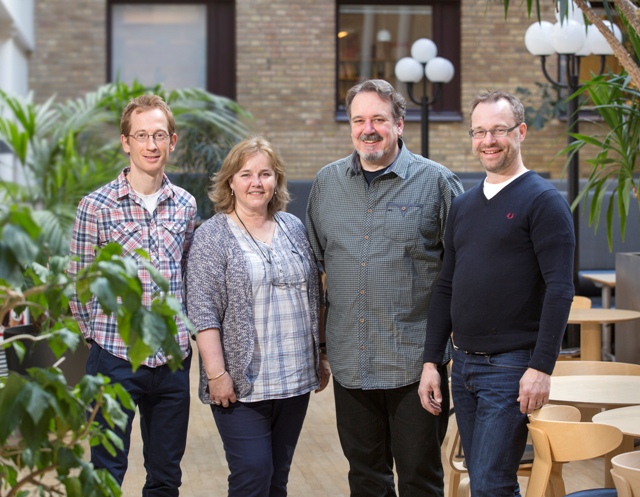Jul 6 2015
 From left Michael Kovermann, Elisabeth Sauer-Eriksson, Uwe Sauer and Magnus Wolf-Watz. Credit: Johan Gunséus.
From left Michael Kovermann, Elisabeth Sauer-Eriksson, Uwe Sauer and Magnus Wolf-Watz. Credit: Johan Gunséus.
Researchers at the Umeå University have successfully captured and described an 'invisible' protein structure that has not been possible until now. This finding lays the foundation for creating designer enzymes that can be used as catalysts for new chemical reactions in various types of applications that include biotechnological applications.
In chemical and cellular reactions, enzymes are utilized as biocatalysts for accelerating the speed of reactions in the order of millions of times. Critical chemical reactions are basically slow in nature. They are very important for all biological life; however, an increase in speed of chemical reactions is very essential.
A team of researchers at the Department of Chemistry at Umeå University have found out a new characteristic in enzymes that provides a partial explanation for the unparalleled efficient and selective manner in which enzymes deal with their tasks.
In order for catalysis of chemical reactions in enzymes, “high-energy states” are considered to be essential. A high-energy level is a temporary occurrence, and it takes place for a short time period.
It is a protein structure, and the various factors affect in combination until the state cannot be seen using conventional spectroscopic techniques. Researchers at Umeå have mutated the protein in adenylate kinase enzyme and have discovered a method to sustain a state of high-energy in this enzyme.
Thanks to this enrichment, we have been able to study both structure and dynamics of this state. The study shows that enzymatic high-energy states are necessary for chemical catalysis.
Magnus Wolf-Watz, Umeå University
This study reveals that an enzyme’s dynamics can be fine-tuned and could help develop new enzymes for catalyst applications in new chemical reactions.
Research on Bioenergy is an active field at Umeå University. An important, practical application of the new knowledge can be enzymatic digestion of useful molecules from wooden raw materials.
Magnus Wolf-Watz, Umeå University
Different types of sophisticated biophysical techniques, including x-ray crystallography and Nuclear Magnetic Resonance (NMR) have helped make the discovery in this study.
One of the strengths of Umeå University is the open cooperative climate with low or no barriers between research groups. It means that exciting research can be conducted in the borderland of differing expertise.
Magnus Wolf-Watz, Umeå University
The results of this study have been published as a paper in the journal Nature Communications.